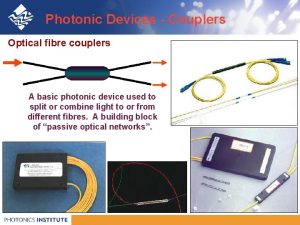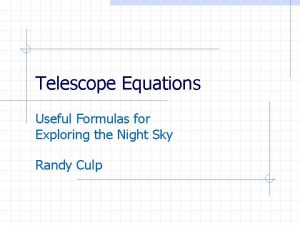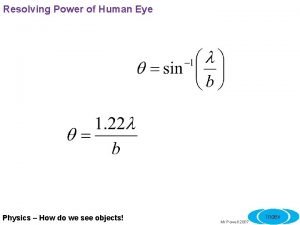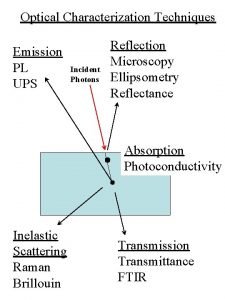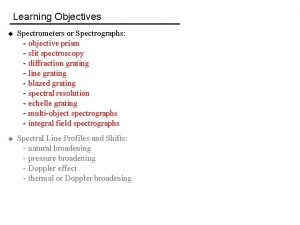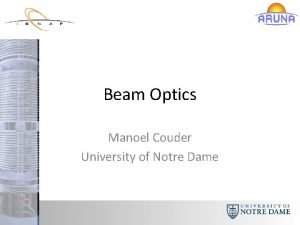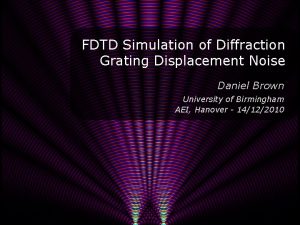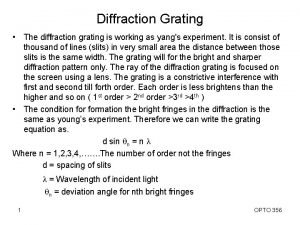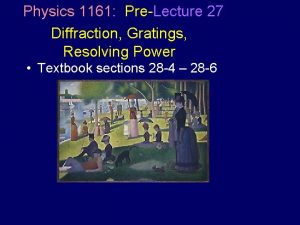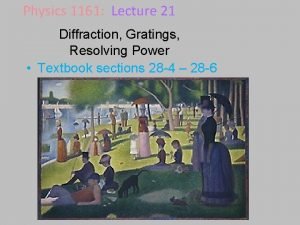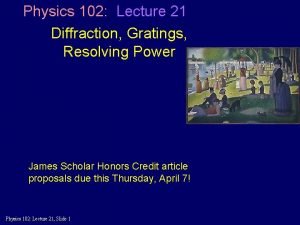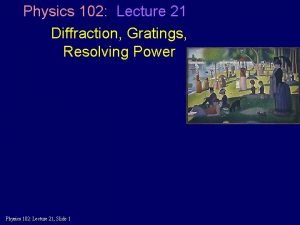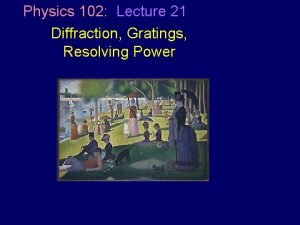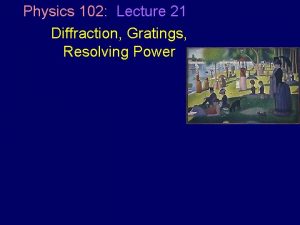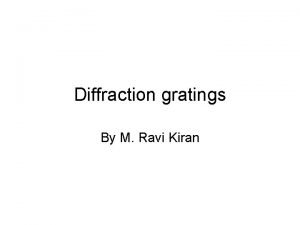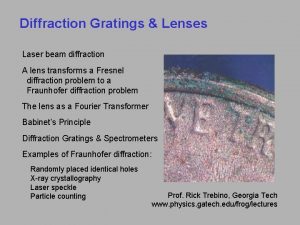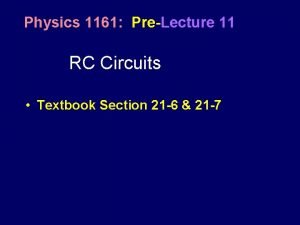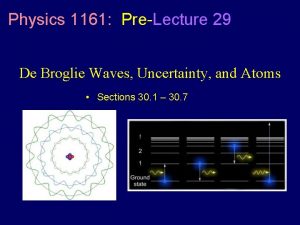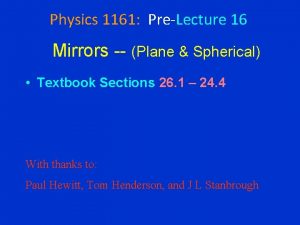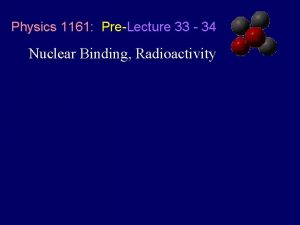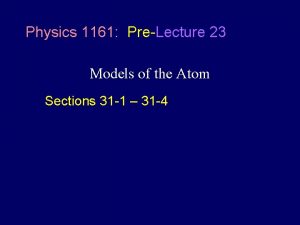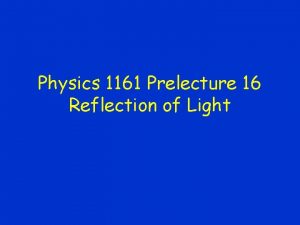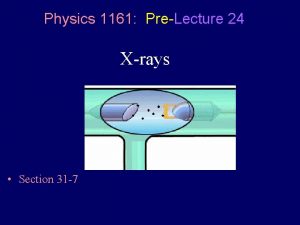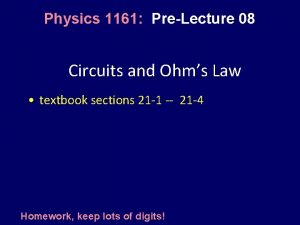Physics 1161 PreLecture 21 Diffraction Gratings Resolving Power


















- Slides: 18

Physics 1161: Pre-Lecture 21 Diffraction, Gratings, Resolving Power • Textbook sections 28 -4 – 28 -6

Recall • Interference (at least 2 coherent waves) – Constructive (full wavelength difference) – Destructive (½ wavelength difference) • Light (1 source, but different paths) – Thin Films – Double/multiple slit – Diffraction/single slit (today)

Young’s Double Slit Review L d Path length difference Which condition gives 1) destructive interference? 2) where m = 0, or 1, or 2, . . . = d sinq d

Multiple Slits (Diffraction Grating – N slits with spacing d) L 1 d 2 d 4 Path length difference 1 -2 d Path length difference 1 -3 3 Path length difference 1 -4 = d sinq =l = 2 d sinq =2 l = 3 d sinq =3 l Constructive interference for all paths when…

Multiple Slits (Diffraction Grating – N slits with spacing d) L 1 d 2 d 4 Path length difference 1 -2 d Path length difference 1 -3 3 Path length difference 1 -4 = d sinq =l = 2 d sinq =2 l = 3 d sinq =3 l Constructive interference for all paths when

9 I 0 Three slit interference

Multiple Slit Interference (Diffraction Grating) Peak location depends on wavelength! For many slits, maxima are still at Region between maxima gets suppressed more and more as no. of slits increases – bright fringes become narrower and brighter. 10 slits (N=10) intensity 2 slits (N=2) 0 l 2 l

Diffraction Grating N slits with spacing d q * screen VERY far away Constructive Interference Maxima are at: Same as for Young’s Double Slit !

Diffraction/ Huygens Every point on a wave front acts as a source of tiny wavelets that move forward. • • Light waves originating at different points within opening travel different distances to wall, and can interfere! We will see maxima and minima on the wall.

Central maximum 1 st minima

Single Slit Diffraction 1 2 W 1 2 When rays 1 and 1 interfere destructively. Rays 2 and 2 also start W/2 apart and have the same path length difference. Under this condition, every ray originating in top half of slit interferes destructively with the corresponding ray originating 1 st minimum at sin q = l/w in bottom half.

Single Slit Diffraction 1 2 1 2 w When rays 1 and 1 will interfere destructively. Rays 2 and 2 also start w/4 apart and have the same path length difference. Under this condition, every ray originating in top quarter of slit interferes destructively with the corresponding ray originating in 2 nd minimum at sin q = 2 l/w second quarter.

Single Slit Diffraction Summary Condition for halves of slit to destructively interfere Condition for quarters of slit to destructively interfere Condition for sixths of slit to destructively interfere All together… (m=1, 2, 3, …) THIS FORMULA LOCATES MINIMA!! Narrower slit => broader pattern Note: interference only occurs when w > l Preflight 21. 3

Diffraction from Circular Aperture 1 st Central maximum diffraction minimum q Diameter D light Maxima and minima will be a series of bright and dark rings on screen First diffraction minimum is at Physics 1161: Lecture 21, Slide 14

Intensity from Circular Aperture I First diffraction minima Physics 1161: Lecture 21, Slide 15

These objects are just resolved Two objects are just resolved when the maximum of one is at the minimum of the other.

Resolving Power To see two objects distinctly, need qobjects » qmin qobjects is angle between objects and aperture: tan qobjects d/y qmin is minimum angular separation that aperture can resolve: sin qmin = 1. 22 l/D D d y Improve resolution by increasing qobjects or decreasing qmin Physics 1161: Lecture 21, Slide 17

Recap. • Interference: Coherent waves – Full wavelength difference = Constructive – ½ wavelength difference = Destructive opposite! • Multiple Slits – Constructive d sin(q) = m l (m=1, 2, 3…) – Destructive d sin(q) = (m + 1/2) l 2 slit only – More slits = brighter max, darker mins • Huygens’ Principle: Each point on wave front acts as coherent source and can interfere. • Single Slit: – Destructive: w sin(q) = m l (m=1, 2, 3…) – Resolution: Max from 1 at Min from 2
 Optical packet switching
Optical packet switching Dispersive power of grating is inversely proportional to
Dispersive power of grating is inversely proportional to Resolving power equation
Resolving power equation Resolving power equation
Resolving power equation Resolving power of human eye in degree
Resolving power of human eye in degree Resolving power
Resolving power Resolving power
Resolving power Resolving power
Resolving power Finite difference time domain
Finite difference time domain Resolving power of grating
Resolving power of grating Power triangle formula
Power triangle formula Chapter 9 lesson 2 resolving conflicts
Chapter 9 lesson 2 resolving conflicts Chapter 9 lesson 2 resolving conflicts
Chapter 9 lesson 2 resolving conflicts 5 steps in resolving ethical dilemmas
5 steps in resolving ethical dilemmas Moral dilemmas examples
Moral dilemmas examples Chapter 9 resolving conflicts and preventing violence
Chapter 9 resolving conflicts and preventing violence Recognizing and resolving abo discrepancies
Recognizing and resolving abo discrepancies Cognitive consumer
Cognitive consumer The favored technique for resolving conflict is *
The favored technique for resolving conflict is *
